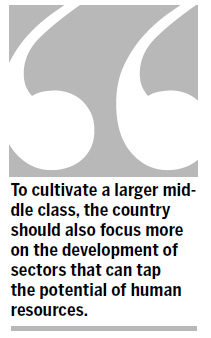
Increasing the number of middle-income earners will be key to the country's long-term and steady economic development
The country will try to increase the number of middle-income earners in the year ahead, the Chinese authorities vowed at the just-concluded Central Economic Work Conference, an annual conference, which sets the tone for the following year's economic development.
Making such a commitment is timely given that the cultivation and expansion of the country's middle class will play a key role in promoting the steady development of the national economy. With the debt crisis in some eurozone countries and the United States posing an unprecedented challenge to the world economy, China needs to change its current income distribution pattern and expand its middle class as a way of boosting long-sluggish domestic demand.
China's middle class began emerging a decade ago. In 2001, 15 percent of the population were middle class. But even if the per capita annual income increased from the current $4,400 to $11,800, still only 23 percent of the population would be middle class, far lower than the average level of developed countries and lower even than other emerging economies.
A key reason for this is that China has failed to carry forward the growth momentum for its middle class. A World Bank report shows that the gap between the rich and poor in China has further widened over the past decade, with the country's Gini coefficient, the most commonly used measure of inequality, already exceeding 0.4 in 2000. This is generally regarded as the international warning level for dangerous levels of inequality. Since then the Gini coefficient has continued growing, reaching 0.496 in 2006 and exceeding 0.5 today. Statistics from the National Bureau of Statistics confirm the widening income disparity, as they show the per capita disposable income of China's top 10 percent urban households was 2.91 times that of the bottom 10 percent in 2005, and the disparity is now a stunning 20-fold.
The lack of a sound and all-inclusive social security network has also contributed to the lack of growth in the proportion of middle-income residents. For example, the current property prices are so high they will immediately plunge any middle-income homebuyers into poverty. Ordinary Chinese families are under a heavy burden if they choose to enter the real estate market, even though the house prices have shown signs of falling following the introduction of government regulatory measures aimed at curbing speculation.
It is encouraging that the central government has finally put the middle class at the top of its agenda, but how to cultivate and expand this group will be a long and arduous task.
To facilitate this goal, the country should try to improve its legislation aimed at protecting private property, as providing effective protection for private property will help create a good investment environment and an effective incentive mechanism, which will benefit the buildup of the private economy and catalyze the formation and growth of the middle class.
The country should also push for thorough reforms of the current housing system and its supply model to stimulate the purchasing power of ordinary middle-income families, which has been almost suffocated by skyrocketing housing prices. It should launch a doubt-track housing market model as soon as possible, in which investment and luxury housing demands are handed over to the market while accommodation demands are handed over to the government. Different land supply and financial support should be given to the two kinds of demands.
It should also push for the establishment of an improved social security, welfare and public service network and try to expand primary distribution reforms in an effort to build an integrated "salary, insurance and welfare" income and taxation system, so as to increase the number of middle-income earners.
To cultivate a larger middle class, the country should also focus more on the development of sectors that can tap the potential of human resources. China is at a critical crossroads and its economic and social development is undergoing a profound transformation. Increasing the number of middle-income earners will help the country realize greater market vitality and economic maturity.
The author is an economics analyst with the State Information Center.
(China Daily 12/19/2011 page8)